
Sargocentron is a genus of squirrelfish found in tropical parts of the Indian, Pacific and Atlantic Oceans, with the greatest species diversity near reefs in the Indo-Pacific. Being largely or entirely nocturnal, they have relatively large eyes. Red and silvery colours dominate. The preopercle spines are venomous and can give painful wounds. Most have a maximum length of 15–25 cm (6–10 in), but S. iota barely reaches 8 cm (3 in), and S. spiniferum can reach more than 50 cm (20 in).

Sargocentron xantherythrum, commonly known as Hawaiian squirrelfish or striped squirrelfish, is a member of the squirrelfish family that is endemic to the Hawaiian Islands. It occasionally makes its way into the aquarium trade. It grows to a length of 17 centimeters (6.7 in).
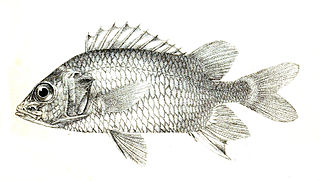
Sargocentron caudimaculatum, the silverspot squirrelfish, is a reef-associated member of the family Holocentridae. It is native to the Indian and Pacific Oceans from East Africa to Japan and northern Australia and as far east as the Marshall Islands. It lives near reefs, but can also be found in lagoons and drop-offs at depths between 2 and 40 metres. It is a nocturnal predator, feeding primarily on crabs and shrimps. It can reach sizes of up to 25.0 centimetres (9.8 in) TL. Although it is caught commercially and can be found in the aquarium trade, there are no known major threats to this species.

Sargocentron coruscum, more commonly known as the reef squirrelfish, is a member of the family Holocentridae native to the western Atlantic Ocean from Florida, USA to northern South America. It lives over sandy and rocky substrates, as well as coral reefs, generally between 1 and 30 metres deep. It is a nocturnal predator, feeding primarily on shrimps, but will also eat crabs. It searches for food alone or in small schools. It can reach sizes of up to 15.0 centimetres (5.9 in) TL. When alarmed, it will hide in crevices between corals.

Sargocentron dorsomaculatum, also known as the spotfin squirrelfish, is a species of squirrelfish found in the western Pacific Ocean near the Ryukyu Islands, Pohnpei, Kosrae, the Caroline Islands, and Palau. It lives in shallow reefs at depths between 2 and 9 metres. Like other members of its genus, it is nocturnal and seeks shelter among corals and other structures. It can reach sizes of up to 19.7 centimetres (7.8 in) SL.

Sargocentron ensifer, or the yellow-striped squirrelfish, is a member of the family Holocentridae. It is native to the Pacific Ocean from southern Japan to New Caledonia, Hawaii and the Pitcairn Islands. It lives in deep reefs at depths between 0 and 64 metres, hiding in crevices by day and foraging for food by night. It feeds on small fishes and crustaceans and can reach sizes of up to 23.0 centimetres (9.1 in) SL, though a length of 15.0 centimetres (5.9 in) TL is more common.

Sargocentron microstoma, the fine-lined squirrelfish, slender squirrelfish or smallmouth squirrelfish, is a member of the family Holocentridae. It has a wide range throughout the Indo-Pacific from the Chagos Archipelago, Seychelles, and the Maldives to the Hawaiian Islands, Line Islands, and the Tuamotus Archipelago, north to the Ryukyu Islands and Bonin Islands, south to Austral Islands and throughout Micronesia. It lives near reefs usually at depths between 1–35 m (3.3–114.8 ft), but can be found as deep as 183 m (600 ft). During the day it hides in crevices, especially near Acropora and Pocillopora. It is a nocturnal predator, feeding on crustaceans, worms, and fishes. It can reach sizes of up to 20 cm (7.9 in) TL and has a venomous preopercle.

Sargocentron cornutum, the threespot squirrelfish, is a member of the family Holocentridae native to the western Pacific Ocean from Indonesia to the Great Barrier Reef. It lives in coral reefs and drop-offs between depths of 6–40 m (20–131 ft). It is a nocturnal predator, feeding on crabs and shrimps by night and hiding under ledges or in caves by day. It can reach sizes of up to 27.0 cm (10.6 in) TL and has a venomous preopercle.
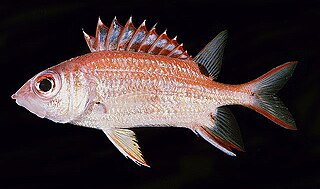
Sargocentron melanospilos, the blackbotch squirrelfish, is a species of squirrelfish in the genus of Sargocentron. It is found in the Indo-Pacific region in the Red Sea; Zanzibar, Tanzania; from Aldabra and Seychelles to the Marshall Islands and American Samoa; north to Taiwan, southern Japan and the Ogasawara Islands, and south to the southern Great Barrier Reef and the Chesterfield Islands. It is a relatively uncommon inhabitant of rocky reefs and coral-rich areas, and is usually seen solitary, but it also forms schools when in deeper water or oceanic areas.

Sargocentron hormion is a species of Squirrelfish belonging to the genus of Sargocentron. It is reported to have been found in Pitcairn, the Cook Islands and French Polynesia. It inhabits rocky bottoms and coral reefs.
Sargocentron inaequalis, the lattice squirrelfish, also known as the roundfinned squirrelfish, is a species of squirrelfish in the genus of Sargocentron. It is found in the Indian Ocean in the Chagos Archipelago, Comoro Islands, Seychelles and Réunion, and in the Pacific Ocean in he Line Islands in Kiribati. It is an uncommon inhabitant of rocky coral reefs.
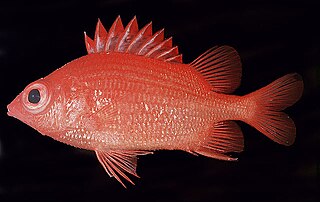
Sargocentron iota, the dwarf squirrelfish, is a nocturnal benthopalegic species of squirrelfish belonging to the genus of Sargocentron. It can be found in the Indo-Pacific region. It inhabits steep outer reef slopes.
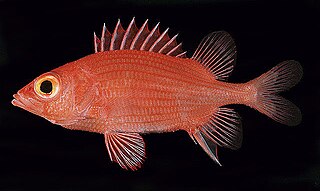
Sargocentron lepros, the spiny squirrelfish, is a nocturnal species of squirrelfish belonging to the genus of Sargocentron. It inhabits the outer reef slopes of oceanic islands, mostly in the Southern Pacific Ocean. It is normally found solitary.
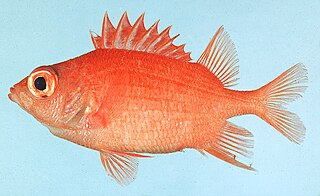
Sargocentron macrosquamis, the big-scale squirrelfish, is a species of squirrelfish belonging to the genus of Sargocentron. It can be found in the Western Indian Ocean, from the Red Sea to Mozambique, and in Seychelles, Maldives and the Chagos Islands.
Sargocentron megalops is a species of squirrelfish belonging to the genus of Sargocentron. It is endemic to Pitcairn in the Central Pacific Ocean. It possesses unusually large eyes, which it is named after, and is thought to be used for penetrating deeper water, suggesting 49m could be the near upper limit of the depth range of where it is found.
Sargocentron poco, the saddle squirrelfish, is a species of squirrelfish belonging to the genus of Sargocentron. It is found in the Western Central Atlantic Ocean from the United States to the Cayman Islands, and in the Bahamas. It may also possibly be found in Cuba. It is likely to be more commonly found inhabiting shelf-edge reefs.
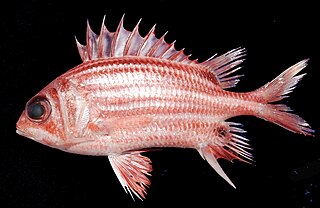
Sargocentrum praslin, the dark-striped squirrelfish, is a species of squirrelfish beloging to the genus Sargocentron. It can be found in the Indian Ocean and the West Pacific Ocean, from East Africa south to Mozambique and east to the Marshall Islands excluding the northern Marshall Islands and the Society Islands. It has also been introduced into Libya, Turkey and Cyprus and may also possibly be found in Egypt and Greece. It inhabits reef flats and shallow protected reefs, often in dead reef areas. It is secretive during the day.

Sargocentron suborbitale, the tinsel squirrelfish, is a species of squirrelfish belonging to the genus Sargocentron. It can be found in the East Pacific Ocean from the Gulf of California to Ecuador including the Galapagos Islands. During the day, adults of the species hide in small caves or crevices of rocks. During the night, they feed on small crustaceans in the intertidal zone. It is oviparous.

Sargocentron tiereoides, the pink squirrelfish, is a species of squirrelfish belonging to the genus Sargocentron. It can be found in the Indian Ocean and the Pacific Ocean, from East Africa to the Line and Society Islands, north to Ryukyu, Japan and Wake Island, south to Vanuatu, through Micronesia. It inhabits outer reef slopes of deeper waters and has been collected on reef flat and lagoon patch reefs. It feeds on benthic crabs and shrimp at night.

Sargocentron violaceum, the violet squirrelfish, is a nocturnal species of squirrelfish in the genus Sargocentron. It can be found in the Indian Ocean and the Pacific Ocean from Aldabra and the Laccadive Islands to the Society Islands, north to Ryukyu, Japan, south to the southern Great Barrier Reef, and from Palau to the eastern Caroline and Marshall Islands in Micronesia. It is an uncommon inhabitant atoll reef flats, lagoon patch reefs, and steep outer reef slopes. It is a solitary and secretive species and can occasionally be seen in small crevices in clear water habitats. It is usually among rich coral growth and it mainly feeds on benthic crabs and shrimps.

















